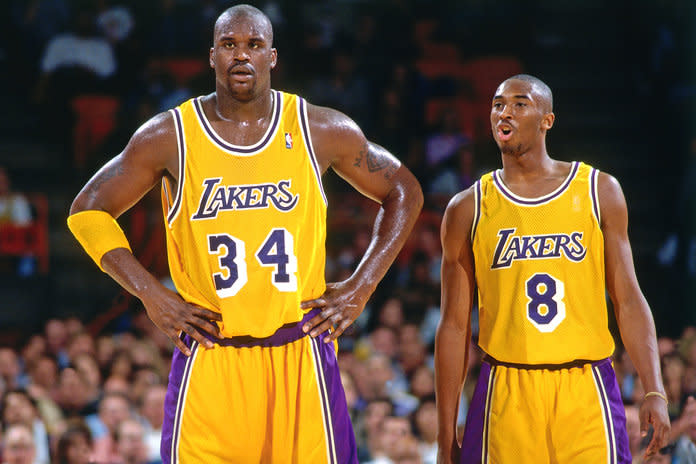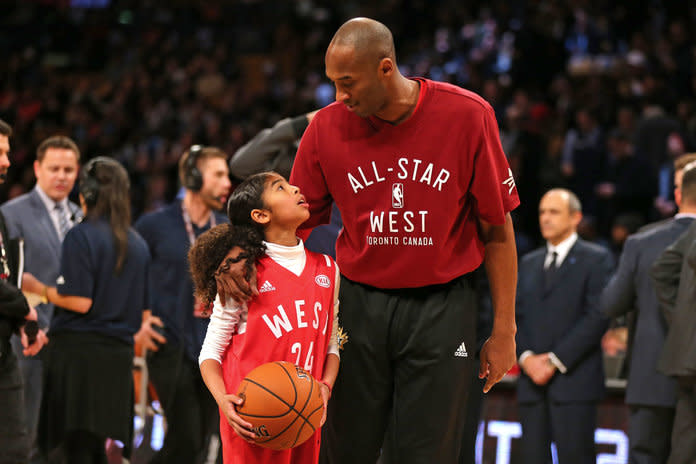Kobe Bryant Was My Idol — but Why Wasn't I Looking up to a Female Star?
Coming in hot after winning the MVP of my Boys & Girls’ Club basketball league in the fourth grade, I decided to focus my “what I want to be when I grow up project” on one day playing professional basketball in Los Angeles, sporting the iconic purple and gold for the LA Sparks, the WNBA team that shared the Lakers’ home court.
I had never watched the Sparks. Though I name-dropped Lisa Leslie to sound like a true WNBA fan, I had never seen her play. It was a Lakers jersey I wore for “sports day” at school. It was the Lakers I watched with my dad on weeknights after homework, yelling at Kobe Bryant to pass the ball, and then yelling at him again when he finally passed it to Shaq, who missed the easy shot. Don’t tell Mr. Dunbeck, but I was a giant fraud, claiming to be a connoisseur of the women’s game when in reality, the WNBA was barely on my radar.
On Sunday, as I absorbed the news of the Kobe’s tragic death — as well as the death of his daughter, Gigi, and seven others — I kept returning to this moment, and all the smaller moments before it that led me to idolize Kobe, Shaquille O’Neal, Derek Fisher, and Rick Fox. Why wasn’t I watching the Sparks or chanting “LISA” when I bricked my three-pointers at the end of practice? In remembering my own devout fandom and the personal connection I felt with Kobe almost 20 years later, all I could see was the hole where a female sports star should have been.

Andrew D. Bernstein/Getty Images
Growing up in Southern California, I saw Kobe everywhere I looked: On TV in my house and on TV in my best friend’s house and on all of the TVs in every strip mall chain restaurant in the greater Orange County and Los Angeles area. You couldn’t visit an outdoor shopping center in the summer without spotting Lakers jerseys en masse, likely #8 or #24, the two numbers Kobe wore. Kobe and his family lived about 30 minutes north of my hometown, inside the same gated community that fenced in the Real Housewives and my physical therapist. Just being inside those gates — you could feel his presence. This is where the legend lived, and everyone knew it.
Female sports, on the other hand, existed. I knew the names of Leslie and Diana Taurasi, but women’s teams were not celebrated on nearly the same plane as the men (they still aren’t). I don’t remember seeing them play on TV, much less going to a game, even during the period when ratings for the league were the highest. Though WNBA regular season and playoff games were broadcast on ABC and ESPN 2 in the league’s early years, viewership peaked in 2005 with an average of 270,000 fans tuning in, before steadily declining throughout the rest of the decade, leading to fewer primetime broadcasts. The WNBA would not reach these numbers again until 2011. By contrast, an average of 3.5 million people watched regular season coverage of the NBA in 2005. I — along with my entire extended family — was among them.
On the heels of her retirement in 2009, Leslie chalked up the perceived lack of interest to a lack of coverage, specifically on local channels, which failed to broadcast league highlights. “Through all my interviews, it’s important to encourage all of these different networks to promote women’s basketball and the WNBA, not just when it’s during the finals, but all season long,” Leslie told Swish Appeal. “Women’s basketball is important and we deserve to have our place and our space in the world of sports.” It wasn’t until 1996, the same year that Kobe was drafted into the NBA, that the WNBA was even created, and in the past 23 years, they’ve continued to struggle for recognition.
Before his death, Kobe had been working to give his daughter Gianna, and young girls like her, role models like I never found. By attending WNBA games, mentoring players, and highlighting their successes, Kobe not only lifted up the professional women in the sport, but all of the young players on his daughter’s club team, which he coached, sharing videos of their skill with his 18.5 million Instagram followers and talking up Gigi’s talent whenever he could.
Last year, the Los Angeles Times reported that Kobe took Gigi’s team to see the Sparks play their season opener in Las Vegas against the Aces, discussing strategy with them on the sideline. According to the report, he had planned to take the girls to several more meet and greets with WNBA players throughout the year, all the while bringing new visibility to the league simply by showing up. “The WNBA is a beautiful game to watch,” he said at the time. “There’s no better way to learn than to watch the pros.”
RELATED: What Is the 'Right' Way to Memorialize Someone?
His words, simple as they were, were like the ultimate form of validation for me, after years of being told (and internalizing) that “the men just play the game better,” and that that was the reason they were paid so much more, were worth more airtime, and made better idols. In the year 2004, there was 99% less money in the WNBA compared to the NBA. The average salary for an NBA player was $4.1million for the 2003-04 season, compared to the WNBA’s average of $50,000. According to an L.A. Times article from the year 2000, many of the world’s best female players chose to play in Europe rather than accept the meager salaries that were offered at the time of the league's inception.
.@WNBA players tell 'little man trolls' to be more creative with their insults in 2019 💪pic.twitter.com/cIr7ps3UXO
— Yahoo Sports (@YahooSports) May 24, 2019
“People need to follow Kobe’s lead, and I’m not just talking about NBA players,” Sparks forward Chiney Ogwumike told the L.A. Times last year. “You look at women’s basketball and the WNBA and a lot of men tend to speak on it without knowing it, and a lot of men tend to be ignorant about women’s basketball players. But you will have a daughter, and I bet you would want your daughter to play in the WNBA if she’s good at basketball. So follow his lead.”
In 2018, ratings for the WNBA rose 36% among viewers in the 18-49 year-old demographic, with a 29% increase of women viewers. ESPN also upped the number of WNBA games broadcast from 13 in 2018 to 16 in 2019. However, according to a Forbes report from 2017, the wage gap between the WNBA and the NBA was widening, with 2017 MVP Sylvia Fowles bringing home $109,000 per year. Meanwhile, the minimum salary for the NBA was $898,310 in 2019.
RELATED: WNBA Players Just Got Better Maternity Benefits Than Most Women in America
But Kobe stayed dedicated to the cause of setting this right. Just last week, a CNN reporter asked him if he believed any WNBA players could play in the men’s league. “Diana Taurasi, Maya Moore, Elena Della Donne … There’s a lot of great players out there so they could certainly keep up with them,” he said.

And then, of course, there was Gigi, poised to become an icon in her own right, her father guiding the way.
“She was really about to be the future of the WNBA, or women’s basketball, period,” Seimone Augustus, a member of the Minnesota Lynx and a friend of Bryant's family, told The Lily on Monday. “She was about to be someone that we had never seen before.”
Kobe and Gigi courtside breaking down the game 📋 pic.twitter.com/FxqSjVx6ew
— ESPN (@espn) December 22, 2019

